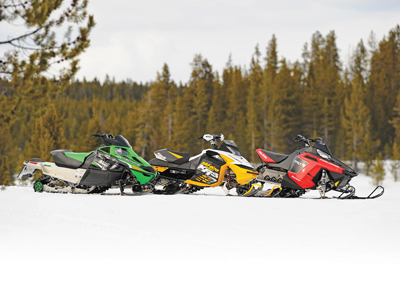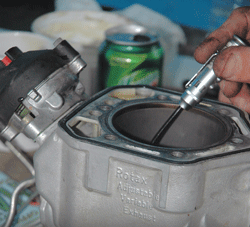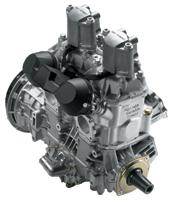 The Lotus engine is a direct-injected, two-stroke powerplant that incorporates some innovative designs to make it clean burning. The crankcase is not used to pump air to scavenge the cylinders. Instead, the bottom end is lubricated by a conventional wet or dry sump design, just like a four-stroke engine. The main bearings and rod bearings are typical flat bearings.
The Lotus engine is a direct-injected, two-stroke powerplant that incorporates some innovative designs to make it clean burning. The crankcase is not used to pump air to scavenge the cylinders. Instead, the bottom end is lubricated by a conventional wet or dry sump design, just like a four-stroke engine. The main bearings and rod bearings are typical flat bearings.
Air is compressed by a two-stage supercharger with the low pressure/high volume air being used to scavenge the cylinders and the high pressure/low volume air being used to assist with the fuel injection. The rotor of a rotary drum valve, driven from the crankshaft, times the delivery of the scavenging air rather than transfer ports.
The stator position of the drum valve is controlled electronically and alters the timing of the scavenging air. The drum valves mount directly to the cylinder heads. The same drum valves, with a separate chamber, also time the input of the air-assisted fuel injector.
Lotus also developed a trapping valve for the exhaust side of the engine. Also a drum-valve design, driven from the crankshaft, the valve times the outlet opening of the exhaust port and eliminates any possible short circuits of the fresh charge through the operating range of the engine.
The direct-injected Lotus engine was completed and tested in 2001 and ended up producing 1/10 of the emissions of a comparable four-stroke engine.
While the Lotus engine remains a concept engine, Bombardier Recreational Products Inc. (BRP) has had its Evinrude E-TEC outboard engines in production since 2003, and continues to expand the line.
The E-TEC system is comprised of four major components: the fuel delivery circuit, the Engine Management Module (EMM) or computer, the oil injection system and the electrical system.
With E-TEC, fuel is injected directly into the combustion chamber after the piston has closed off the exhaust port. This means that fresh air has already been drawn into the crankcase, has been pumped through the transfer ports to the cylinder by the descending piston and has been partially compressed by the ascending piston — all before gasoline is added to the mix. Short circuiting of fuel out the exhaust port isn’t possible, but because of the compression pressure on the fresh air charge, high pressure injection is necessary.
The E-TEC system utilizes two fuel pumps. The first pump is pulse operated and delivers fuel from the tank to a water-cooled fuel vapor separator. The second is a high volume, electronic distribution pump that delivers a constant flow of fuel to the injectors at 25 psi.
The constant fuel pressure reduces the chance of vapor lock — even on hot days. The water-cooled fuel-vapor separator diverts atomized fuel away from the fuel delivery pump and into the intake manifold, where it is delivered for combustion in the engine.
The system utilizes one fuel injector per cylinder, mounted directly on the cylinder head and aimed at the spark plug. The fuel injector is a combination injector pump and injector nozzle. The injector pump/nozzle is electromagnetic and operates similarly to a solenoid but is equipped with a permanent magnet. The injector operates like an audio speaker and is referred to as a voice coil injector.
The EMM sends voltage to the injector as required by its program to “slam” fuel into the cylinder at up to 300 psi. The EMM cycles the voltage on and off at up to 100 times per second, which can occur within 1/4 of a crankshaft revolution at an accuracy of +/- 3 crankshaft degrees. The amount of fuel delivered into the cylinder at the injector nozzle is determined by the amount of current and the duration of the electrical pulse from the EMM. As the engine rpm rises, the EMM sends more current with longer pulse times to inject the proper amount of fuel.
The EMM is a powerful microprocessor that controls the fuel delivery system, ignition system, oil injection system, exhaust port height — on models equipped with variable exhaust valves — and stores troubleshooting, maintenance and service information. The EMM is capable of making 8 million calculations per second.
The electrical system is powered by a huge, 50-amp alternator capable of charging backup as well as standard batteries on board along with powering the fuel and oil delivery and ignition systems. The liquid-cooled EMM interfaces with numerous sensors mounted around the engine.
Among other things, sensors monitor throttle position, engine temperature, air intake temperature, crankshaft position, neutral position, engine rpm, barometric pressure (which allows the system to compensate for changes in altitude and barometric pressure) and fuel and oil delivery pressure.
Delivery from the injector nozzles is highly atomized and is delivered in a stratified condition — richer near the spark plug and leaner toward the cylinder walls. A splash bowl in the piston dome confines the mixture during early combustion. The entire fuel charge is burned, with none lost out the exhaust port. This results in increased fuel economy, reduced emissions and smooth idling and operation throughout the rpm range.
The EMM also controls the high-frequency, high-energy CDI system. BRP’s system is designed to trigger the ignition coils multiple times for each revolution of the engine. The spark plugs fire multiple times at idle and low speeds and drops to one or two discharges at higher engine speeds. This rapid firing of the coil and plugs ensures uniform ignition of the fuel charge, eliminating the possibility of fouled plugs due to misfires.
Lubrication of the engine is accomplished by a total loss, oil injection system. An electric oil pump with the help of a pressure transducer are monitored by the EMM and oil pressure is adjusted as necessary. Oil is delivered to the inlet side of each cylinder, and a smaller amount of oil is delivered to the incoming fuel to help keep the injectors clean. Internal and external oil passages allow residual oil to be collected and fed to the main bearings of the crankshaft. The top main bearing cavity is vented to the intake manifold to promote oil passage through the oil recirculation circuits. Check valves in the passages keep the oil marching through the system.
The Evinrude E-TEC engine can be described as a very simple engine design controlled by a very powerful computer.
Because BRP designed and built the E-TEC engine, it looks like a wonderful next step in cleanliness over the semi-direct injected two-stroke engines currently powering several “clean” Ski-Doo and Polaris models.



